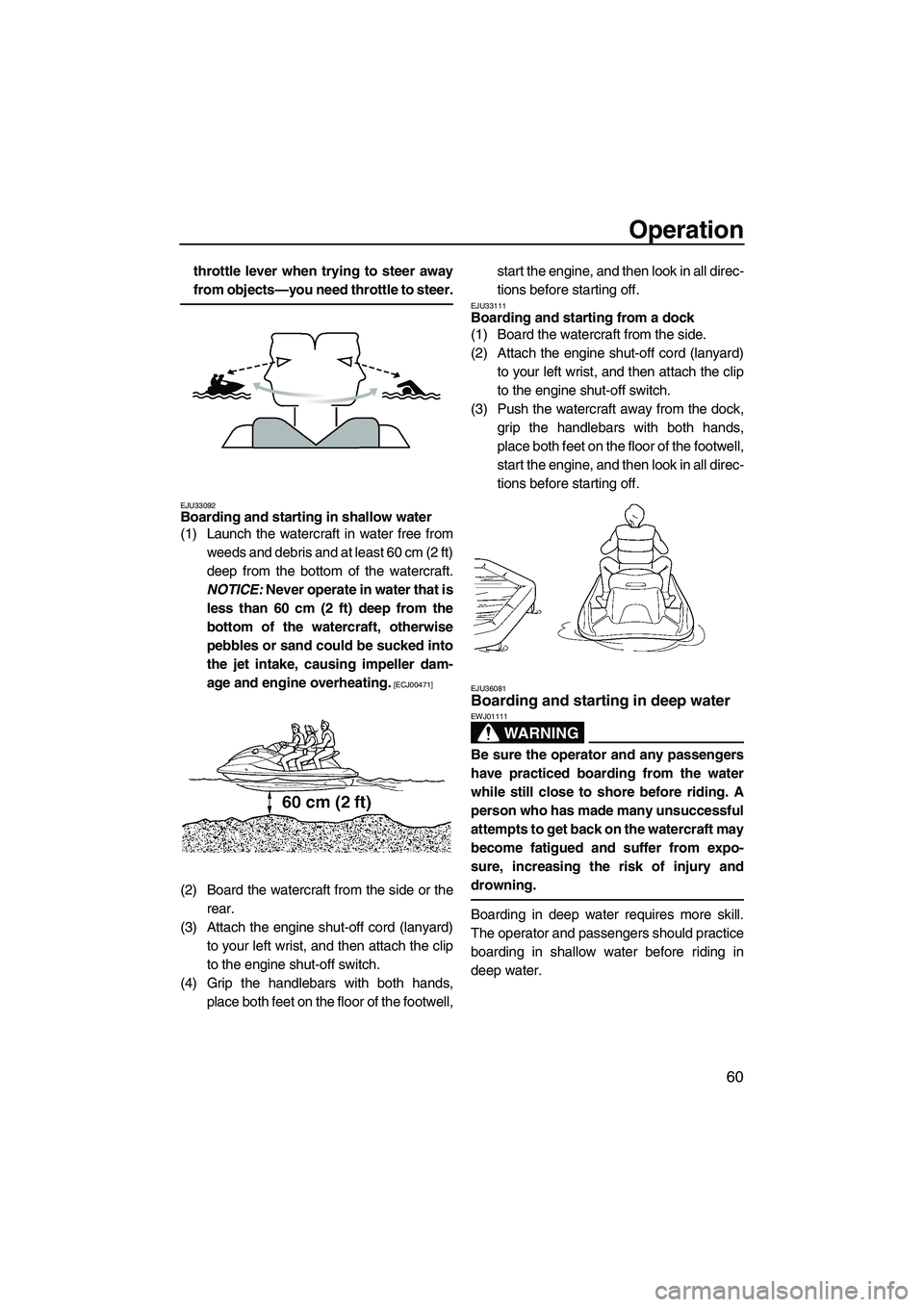Page 45 of 98

Features and functions
38
maximum engine speed is limited to help pre-
vent damage.
If this occurs, immediately reduce the engine
speed, return to shore, and then check the en-
gine oil level. (See page 47 for engine oil level
checking procedures.) If the oil level is suffi-
cient, have a Yamaha dealer check the water-
craft.
TIP:
Push the “Hour Volt” button to stop the buzz-
er.
EJU37300Engine overheat warning
If the engine temperature rises significantly,
the “WARNING” indicator light and the engine
overheat warning indicator blink, and the
buzzer sounds intermittently. Then, the
“WARNING” indicator light and the engine
overheat warning indicator stop blinking and
remain on, and the buzzer sounds continu-ously. After the light and indicator start to blink
and the buzzer sounds, the maximum engine
speed is limited to help prevent damage.
If this occurs, immediately reduce the engine
speed, return to shore, and then check for wa-
ter discharge at the port (left) cooling water pi-
lot outlets while the engine is running. If there
is no discharge of water, shut the engine off,
and then check the jet intake for clogging.
(See page 85 for jet intake cleaning proce-
dures.) NOTICE: If you cannot locate and
correct the cause of the overheating, con-
sult a Yamaha dealer. Continuing to oper-
ate at higher speeds could result in severe
engine damage.
[ECJ00041]
1“Hour Volt” button
1
UF2C70E0.book Page 38 Monday, November 3, 2008 10:16 AM
Page 63 of 98
![YAMAHA FZS 2009 Owners Manual Operation
56
pebbles or sand could be sucked into
the jet intake, causing impeller dam-
age and engine overheating.
[ECJ00471]
(3) Attach the engine shut-off cord (lanyard)
to your left wrist, and th YAMAHA FZS 2009 Owners Manual Operation
56
pebbles or sand could be sucked into
the jet intake, causing impeller dam-
age and engine overheating.
[ECJ00471]
(3) Attach the engine shut-off cord (lanyard)
to your left wrist, and th](/manual-img/51/50223/w960_50223-62.png)
Operation
56
pebbles or sand could be sucked into
the jet intake, causing impeller dam-
age and engine overheating.
[ECJ00471]
(3) Attach the engine shut-off cord (lanyard)
to your left wrist, and then attach the clip
to the engine shut-off switch. It is not pos-
sible to start the engine with the clip re-
moved from the engine shut-off switch.
WARNING! Check that the engine
shut-off cord (lanyard) is attached cor-
rectly. If the engine shut-off cord (lan-
yard) is not attached correctly, it may
not pull free when the operator falls
off, allowing the watercraft to continue
to run and cause an accident.
[EWJ00581]
(4) Push the start switch (green button), and
then release it as soon as the engine
starts to run. If the engine does not startin 5 seconds, release the start switch,
wait 15 seconds, and then try again. The
engine will not start if the throttle lever is
squeezed. NOTICE: Never push the
start switch while the engine is run-
ning. Do not operate the start switch
for more than 5 seconds, otherwise
the battery will be discharged and the
engine will not start. Also, the starter
motor could be damaged.
[ECJ01040]
EJU32861
Stopping the engine
To stop the engine, release the throttle lever,
and then push the engine stop switch (red
button). WARNING! You need throttle to
steer. Shutting the engine off can cause
you to hit an obstacle you are attempting
to avoid. A collision could result in severe
injury or death.
[EWJ00601]
1Clip
2Engine shut-off switch
3Engine shut-off cord (lanyard)
31
2
UF2C70E0.book Page 56 Monday, November 3, 2008 10:16 AM
Page 67 of 98

Operation
60
throttle lever when trying to steer away
from objects—you need throttle to steer.
EJU33092Boarding and starting in shallow water
(1) Launch the watercraft in water free from
weeds and debris and at least 60 cm (2 ft)
deep from the bottom of the watercraft.
NOTICE: Never operate in water that is
less than 60 cm (2 ft) deep from the
bottom of the watercraft, otherwise
pebbles or sand could be sucked into
the jet intake, causing impeller dam-
age and engine overheating.
[ECJ00471]
(2) Board the watercraft from the side or the
rear.
(3) Attach the engine shut-off cord (lanyard)
to your left wrist, and then attach the clip
to the engine shut-off switch.
(4) Grip the handlebars with both hands,
place both feet on the floor of the footwell,start the engine, and then look in all direc-
tions before starting off.
EJU33111Boarding and starting from a dock
(1) Board the watercraft from the side.
(2) Attach the engine shut-off cord (lanyard)
to your left wrist, and then attach the clip
to the engine shut-off switch.
(3) Push the watercraft away from the dock,
grip the handlebars with both hands,
place both feet on the floor of the footwell,
start the engine, and then look in all direc-
tions before starting off.
EJU36081Boarding and starting in deep water
WARNING
EWJ01111
Be sure the operator and any passengers
have practiced boarding from the water
while still close to shore before riding. A
person who has made many unsuccessful
attempts to get back on the watercraft may
become fatigued and suffer from expo-
sure, increasing the risk of injury and
drowning.
Boarding in deep water requires more skill.
The operator and passengers should practice
boarding in shallow water before riding in
deep water.
UF2C70E0.book Page 60 Monday, November 3, 2008 10:16 AM